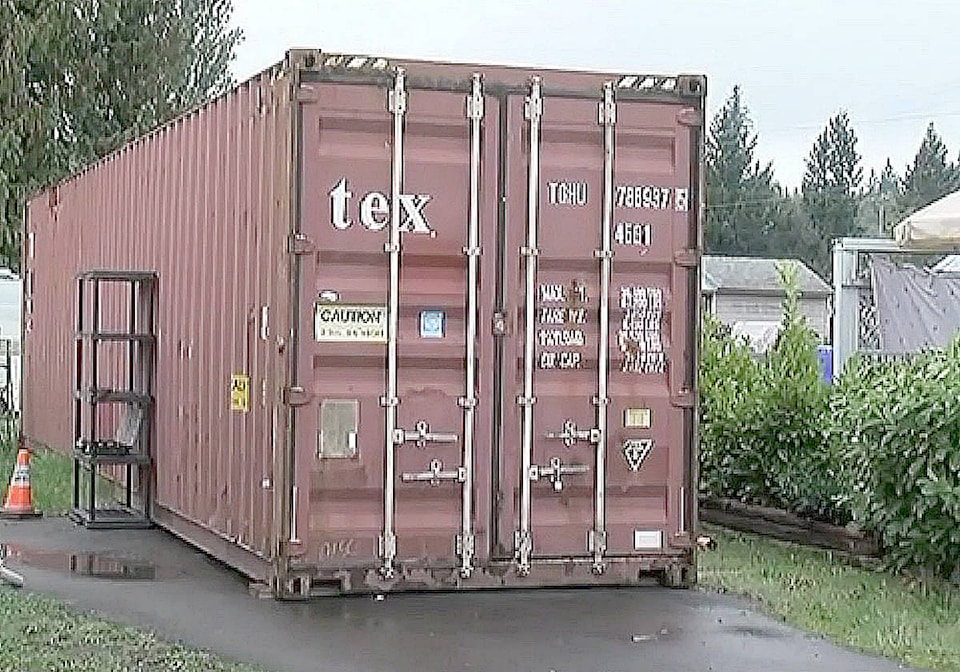While Campbell River city council thinks about what they will do to address the use of shipping containers on residential property, WorkSafe BC says using them for anything other than shipping at all is very, very dangerous.
“The containers are designed to be watertight, which means they are well sealed with little or no ventilation — ideal for shipping purposes but potentially dangerous for other uses,” says Dan Strand, director of prevention field services for WorkSafe BC.
In 2013, a propane barbecue stored inside a shipping container caused an explosion that blew one of the container’s 113 kg doors 40 metres into a public park, WorkSafe BC says. They also say that because the floorboards of shipping containers are often treated with toxic chemicals to protect ago during shipping – or toxic chemicals themselves may have been shipped using the containers – that presents another risk to those using them for non-shipping purposes.
While not considering any kind of outright ban on the use of shipping containers, Campbell River city council is currently awaiting recommendations from city staff on how to possibly regulate their use on residential property after the issue reared its head again last year when a petition was presented to council from a group of 32 Campbellton property owners calling on the city to implement restrictions.
“It’s been probably close to a half dozen years that the conversation with regards to shipping containers – particularly on residential properties and how they could potentially impact residential neighbourhoods – has been a discussion topic throughout the community,” says development services supervisor Kevin Brooks.
Brooks says have been gathering feedback from the community on how the public feels they should be addressing this particular issue so they can work it into the soon-to-be-revamped zoning bylaw. They will add the recent feedback to what they heard from the community back in 2013 “when this originally reared its head in regards to the direction we could possibly go,” Brooks says.
“One of the things there seems to be support for, so far in the process, is the idea that the use of shipping containers shouldn’t be a permanent thing on residential properties, but temporary use for people that are moving or doing construction projects and need that temporary storage is a reasonable consideration.”
In looking around the rest of the province, Brooks says, “what we found is that other communities typically have the ability to have shipping containers on a residential property for a time frame, which ranges from between 30 to 90 days.”
“It’s still very much a work in progress,” Brooks says, and there will be plenty of time for the community to have input on the zoning bylaw before anything is set in stone, “but the sort of high-level proposal right now is to restrict them to temporary use.”
What won’t happen, at least at this point, will be any restrictions for businesses or use of shipping containers on commercial property, Brooks says. That was one of the major sticking points back in 2013 when the city was considering implementing a restriction.
“If it’s deemed an issue by the community or deemed an issue by council, it’s something we can look at,” Brooks says. “But at this stage we don’t have any proposals to restrict them on industrial or commercial properties.”
The reason the city is involved in this debate at all, Brooks says, is because they are responsible for the “community aesthetic.”
“If you have a whole bunch of derelict looking shipping containers on the front of your property,” Brooks says, “what does that do for the character of the neighbourhood?”
Right now, the only way for the city to “regulate” anything in terms of shipping container use is by using the public nuisance bylaw for unsightly property, which is judged on a case-by-case basis and is a subjective decision, so they would like to get something on the books that sets the rules in place a little more objectively.
Brooks says he expects the recommendations to come back before council “around the end of March, with the idea that the administrative changes to the zoning bylaw would be addressed around mid-to-late April, is my understanding.”
